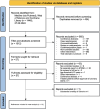Invasive Strategy With Intended Percutaneous Coronary Intervention Versus Conservative Treatment in Older People With ST-Segment-Elevation Myocardial Infarction: A Meta-Analysis
- PMID: 40207486
- PMCID: PMC12132903
- DOI: 10.1161/JAHA.124.040435
Invasive Strategy With Intended Percutaneous Coronary Intervention Versus Conservative Treatment in Older People With ST-Segment-Elevation Myocardial Infarction: A Meta-Analysis
Abstract
Background: Patients ≥80 years old were underrepresented or excluded from landmark trials demonstrating the superiority of primary percutaneous coronary intervention (PCI) in ST-segment-elevation myocardial infarction. The current meta-analysis assessed the effects of an invasive strategy with intended PCI compared with conservative treatment in older people (≥80 years) with ST-segment-elevation myocardial infarction.
Methods: A structured literature search was performed. The primary outcome was overall survival. Secondary outcome analyses included but were not limited to 30-day and 1-year mortality.
Results: Thirteen studies reporting on 102 158 older adults were included. Of these, 31 629 (31%) were assigned to PCI and 70 529 (69%) were treated conservatively. The overall survival was 76.5% in PCI and 67.2% in conservative treatment at the time of longest available follow-up (odds ratio [OR], 2.18 [95% CI, 1.79-2.66], P<0.001, I2=88%, favoring PCI). The follow-up period ranged from 30 days to 26.5 months. The 30-day. (OR, 0.39 [95% CI, 0.31-0.50], P<0.001, I2=0%) and 1-year mortality (OR, 0·34 [95% CI, 0.25-0.46], P<0.001, I2=0%), were lower in the PCI group.
Conclusions: This meta-analysis indicates a potential underuse of PCI in older adults with ST-segment-elevation myocardial infarction. PCI was advantageous in short- and long-term survival, but these results were affected by confounding. Nonetheless, every second patient not referred for invasive treatment survived at least 1 year. These findings have hypothesis generating implications, but they indicate ageism and emphasize that PCI should not be automatically withheld in older patients.
Keywords: STEMI; centenarians; nonagenarians; octogenarians; optimal medical therapy; percutaneous coronary intervention.
Conflict of interest statement
Sascha Macherey‐Meyer:received travel costs from Bayer Vital AG; received research grants from Elisabeth & Rudolf Hirsch Foundation; participates as subinvestigator in a clinical trial sponsored by AstraZeneca. Sebastian Heyne: travel grant from Eli Lilly, research grant from Deutsche Herzstiftung e.V. Stephan Baldus: received lecture fees from Abbott, Edwards, AstraZeneca and JenaValve; received research grants from Abbott and AstraZeneca; participates as principal investigator in a clinical trial sponsored by AstraZeneca. The remaining authors have no disclosures to report.
Figures




References
-
- Salah HM, Minhas AMK, Khan MS, Khan SU, Ambrosy AP, Blumer V, Vaduganathan M, Greene SJ, Pandey A, Fudim M. Trends in hospitalizations for heart failure, acute myocardial infarction, and stroke in the United States from 2004 to 2018. Am Heart J. 2022;243:103–109. doi: 10.1016/j.ahj.2021.09.009 - DOI - PubMed
Publication types
MeSH terms
LinkOut - more resources
Full Text Sources
Miscellaneous

